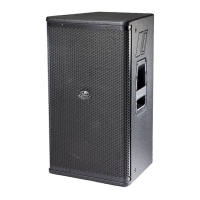6
- Use the eight ohm table when connecting a
single eight ohm speaker per channel. For
instance, one in each channel of a stereo
amplifier or the high frequency band of an
.
- Use the four ohm table when connecting
two eight ohm speakers to an amplifier
channel. For instance, two units in
parallel. Also for one four ohm speaker per
channel, such as for one per channel.
When connecting more than one speaker to an
amplifier channel there are two wiring options. The
first is to run cable from the amplifier's output
terminals to each speaker. The second is to
connect the closest speaker to the amplifier and
then connect the two speakers together with a
loop through cable that has a Speakon NL4
connector on both ends. We'll be paralleling
speakers in both cases. The latter is the most
common and practical option, the former providing
a higher damping factor.
Never use a total impedance load that is lower
than the lowest impedance that an amplifier will
take. Virtually all professional amplifiers will accept
loads down to four ohms safely in stereo mode.
Many are rated for two ohm loads but often will
run into overheating protection when used this
way, particularly in high ambient temperature and
high output power applications. Never connect
more speakers to an amplifier's channel than it will
take, i.e. do not load a channel with a total
impedance that is lower than the minimum load
specified by the manufacturer.
Rf-15.85
Rf-
215.96
Rf-1585
sub-218G
Avoid series or series-parallel wiring schemes
for products, since they degrade sound
quality and thus we do not recommend them for
applications other than background music, paging,
or surround sound.
Rf series
This section provides information on the pin
assignments and basic set-up for the different
enclosures. The "System Configurations" section
adds stereo system configurations with or without
sub-woofer reinforcement. The “Application
Examples” section adds complete application
specific system examples.
Some models, due to the complexities of their
electronic processing, require the indicated D.A.S.
controller for the system to run correctly. Others
may use generic crossover units with
recommended settings, although the use of the
D.A.S. processors is recommended. In general, we
stress the importance of the use of the D.A.S.
processors, since they are shipped with set energy
balances and crossover frequencies, and
adjustments cannot be made that could endanger
system components. By using the D.A.S.
processors, we can ensure the correctness of the
sound and the reliability of the systems.
The following table shows the basic features of
the D.A.S. Controllers:
Basic connection
Model
CT-1 DSP-26
Stereo
2 x (2 way/3 way)
Variable per way
Type
Stereo
Modes
Full range/2way
Limiters
---
Xover freqs
100 Hz
Variable depending on the system
Gain controls
Low Low-Mid-High
EN
Manual del Usuario /r /User’s Manualeference

